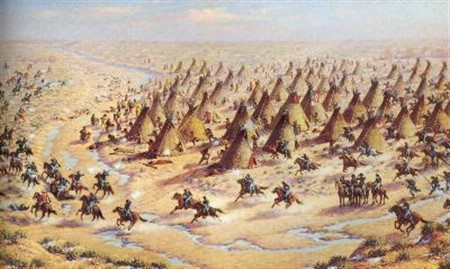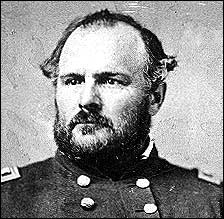To the Arapaho, Sioux, and
Cheyenne, it seemed as if the Great White Fathers now looked upon
Horse Creek as another worthless document signed by people who were
seen as nothing more than obstacles to the march of empire.
Like the treaties that preceded Horse Creek and all that were yet
to follow in the next twenty years, the ground-breaking agreement
forged between the Great White Fathers and the "wild and savage"
tribes of the American Plains could fulfill its promise through
rigid enforcement, but there is scant evidence to suggest that
Congress ever gave serious consideration to this aspect of
treaty-making. And no single event of that period would attest to
the solemn consequences of Washington's neglect more than the Sand
Creek massacre of December 29, 1864.
click
here for more
When he heard
that Chief Black Kettle's band of Cheyenne were settled into their
winter camp a few miles northeast of the frontier town of Denver, a
firebrand Methodist minister, Colonel John Chivington, led his
mounted command on a night-long march in search of the Indians.

An artist's depiction of the Colorado milita's massacre
of Black Kettles band of Cheyenne women, children, and old people,
at Sand Creek in 1864. Soldiers paraded with babies impaled
on bayonettes, while others eviscerated the sexual organs of
murdered women and stretched them over their hats like ornamental
hat bands. "What we have learned about the Americans," said
Cherokee philosopher John Ross, "is that the perpetrator of these
crimes never forgives his victims."
click
here for more
Having recently
signed a new treaty of peace, Black Kettle had been promised
protection by the U.S. Army from other bands of Indians that were
trying to wrest away the Cheyenne hunting ground in eastern
Colorado. Black Kettle, whose camp of a hundred lodges was
made up of mostly women, children, and old people, had proclaimed
his neutrality in all the skirmishes being fought on the
countryside around his winter camp. With nothing to fear, the
members of his band lay peacefully asleep as dawn broke on a cold
winter morning.
When Black
Kettle stepped from his lodge and saw the frieze of blue coats
arrayed on the cut bank above the village, he quickly raised the
American flag on a standard to display his neutrality, but the
gesture was ignored. When Colonel Chivington was asked what they
should do about the women and children, he ordered his men to kill
them all. Then, he waved his saber in the air and ordered his
troops to open fire.

"Then the scene
of murder and barbarity began -- men, women, and children were
indiscriminately slaughtered," reads the report from Congress'
official investigation. "In a few minutes all the Indians
were flying over the plain in terror and confusion. A few who
endeavored to hide themselves under the bank of the creek were
surrounded and shot down in cold blood. From the sucking babe
to the old warrior, all who were overtaken were deliberately
murdered. Not content with killing women and children who
were incapable of offering any resistance, the soldiers indulged in
acts of barbarity of the most revolting character; such, it is to
be hoped, as never before disgraced the acts of men claiming to be
civilized. No attempt was made by the officers to restrain the
savage cruelty of the men under their command, but they stood by
and witnessed these acts without one word of reproof."
Congressional
investigators called Chivington's interpreter, John S. Smith, to
submit to cross examination before members of Congress.
Investigator: Were the women and children
slaughtered indiscriminately, or only so far as they were with the
warriors?
Smith: Indiscriminately.
Investigator: Were there any acts of barbarity
perpetrated there that came under your own observation?
Smith: I saw the bodies of those lying there cut
all to pieces, worse mutilated than any I ever saw before, the
women all cut to pieces.
Investigator: How cut?
Smith: With knives; scalped; their brains knocked
out; children two or three months old; all ages lying their, from
suckling infants up to warriors.
Investigator: Did you see it done?
Smith: Yes sir, I saw them fall.
When the guns fell
silent, after the screams and wails of the dying had fallen quiet
and the last crying babies had been run through with bayonets, the
sordid work of the troops commenced in earnest. As their
commander looked on from the bluff above the village, Chivington's
troops worked their way through the village from lodge to lodge,
lopping off ears and fingers as they went, and gathering ornaments
and scalps from the victim's bodies. Then came the signature
atrocity of this massacre, the dissection of the women's genitalia
with bayonets and Bowie knives. Commonly, the eviscerated
body parts were stretched over the soldier's caps and worn as
hatbands - the prized souvenirs of battle. When Chivington and his
men rode into Denver, they were welcomed by the governor and a
throng of citizens as conquering heroes, all hats bristling.
The God-fearing women of Denver then collected the scalps and
mutilated genitalia of the Cheyenne women and children and hung
them like a Christmas swag over the stage at the Denver opera
house.
The
government's investigation concluded: "As to Colonel Chivington,
your committee can hardly find fitting terms to describe his
conduct. Wearing the uniform of the United States, which
should be the emblem of justice and humanity…he deliberately
planned and executed a foul and dastardly massacre which would have
disgraced the veriest savage among those who were the victims of
his cruelty…and took advantage of their inapprehension and
defenseless condition to gratify the worst passions that ever
cursed the heart of man. Whatever may have been his motive, it is
to be hoped that the authority of this government will never again
be disgraced by acts such as he and those acting with him have been
guilty of committing."
Chivington and his men rode away from Sand Creek as bona fide
heroes in the eyes of their fellow Colorado citizens. Despite
the blistering verdict of congressional investigators, neither the
Methodist minister, nor any of his subordinates, was ever punished,
fined, or court marshaled for their deeds. The United States
government promised to compensate the Cheyenne and Arapaho for the
massacre committed at Sand Creek, but when the treaty reached the
Senate for ratification, the Select Committee on Indian Affairs
quietly deleted that provision. "Today, Indians remember that the
United States Army, led by a Methodist minister, ruthlessly
slaughtered nearly five hundred defenseless Indians," wrote the
late Sioux legal scholar, Vine Deloria Jr., in Utmost Good
Faith. "Before
there can be any warm feelings that we are all "one people," the
United States government must make compensation to the Cheyenne and
Arapahos for Sand Creek."
Related Events
Related Flashpoints
Related Places